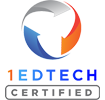
The International Society for Technology (ISTE) is a non-profit that “help(s) educators around the world use technology to solve tough problems in education.” The company is probably best known for its annual conferences held in various cities throughout the country. More than 18,000 educational leaders come from all over the world to attend this event.
And we couldn’t be more proud to be presenting in the upcoming ISTE 2018 conference.
For the past decade, we’ve been building, evaluating, re-building and fine-tuning a dashboard that aggregates data for administrators in one simple view within an LMS or SIS.
Why does having easy access to so much data matter for schools and administrators? Well, we’d love to tell you. At the ISTE Conference, of course.
Here’s a little info on our upcoming presentation.
This Year's Presenter
As a data scientist for StrongMind, it would make sense for Amy to be this year’s presenter. Some fun facts about Amy:
 Hobbies:
Hobbies:
Cooking, Volunteering on Crisis Text Hotline, and anything that is physical and also social at the same time, in other words for Amy, rock climbing and social dancing.
Her spirit animal:
In her words, “Dogs are my heart.”
Dismantling the Data Tower: Empowering Teachers with Data-Driven Decision Making Abstract
Here’s a sneak peek of our upcoming presentation:
Summary:
Teacher-facing dashboards have become the dominant way to present student data in learning analytics (LA). This success has made dashboards the norm for teachers.
But as modern educational systems produce large volumes of highly dimensional student data, it becomes increasingly difficult to interpret it. A natural progression for the field is to bring machine learning (ML) into dashboards to condense data signals into understandable explanations of student behavior.
This paper (see PDF) examines how StrongMind created a teacher-facing dashboard that aggregates all useful student data points for the StrongMind learning management system (LMS) ecosystem.
Furthermore, StrongMind developed an ML model to evaluate student academic risk. The dashboard used this model to present student data in order of academic risk, using moment-to-moment updates to show teachers which students most needed their help.
After several months of dashboard use, StrongMind found that student final grades had improved by 3.05% (p < 0.05) and that the proportion of disengaged students had significantly dropped compared to the previous year when there were no dashboards.
Methods Used
The following table shows student grade counts for dashboard and comparison groups
| Group | 9 | 10 | 11 | 12 | All |
| Dashboard | 134 | 227 | 210 | 450 | 1021 |
| Comparison | 234 | 495 | 577 | 828 | 2134 |
Results
| Research Question | Results |
| What effect did the introduction of the dashboard have on student academic outcomes? | Following the introduction of the dashboard, mean student final grade improved (p < 0.05, % = 3.05, d = 0.10). |
| What effect did the introduction of the dashboard have on the proportion of students who were disengaged in their course? | A reduction in the proportion of disengaged students in the dashboard group compared to the comparison group (p < 0.05, % = -2.62%). |
You’ll get to learn more about these results and what they mean at the conference. Other presenters include Jay Manjunath and Jason Tourville who will represent Primavera Online High School, Arizona’s largest online high school.
If you’re headed to the ISTE Conference, we hope to see you there. You can learn more about the presentation here.
If you aren’t attending the conference, we will post our presentation afterward. Stay tuned!





